高中英语模块3 unit 2 的单元课件
文档属性
| 名称 | 高中英语模块3 unit 2 的单元课件 | 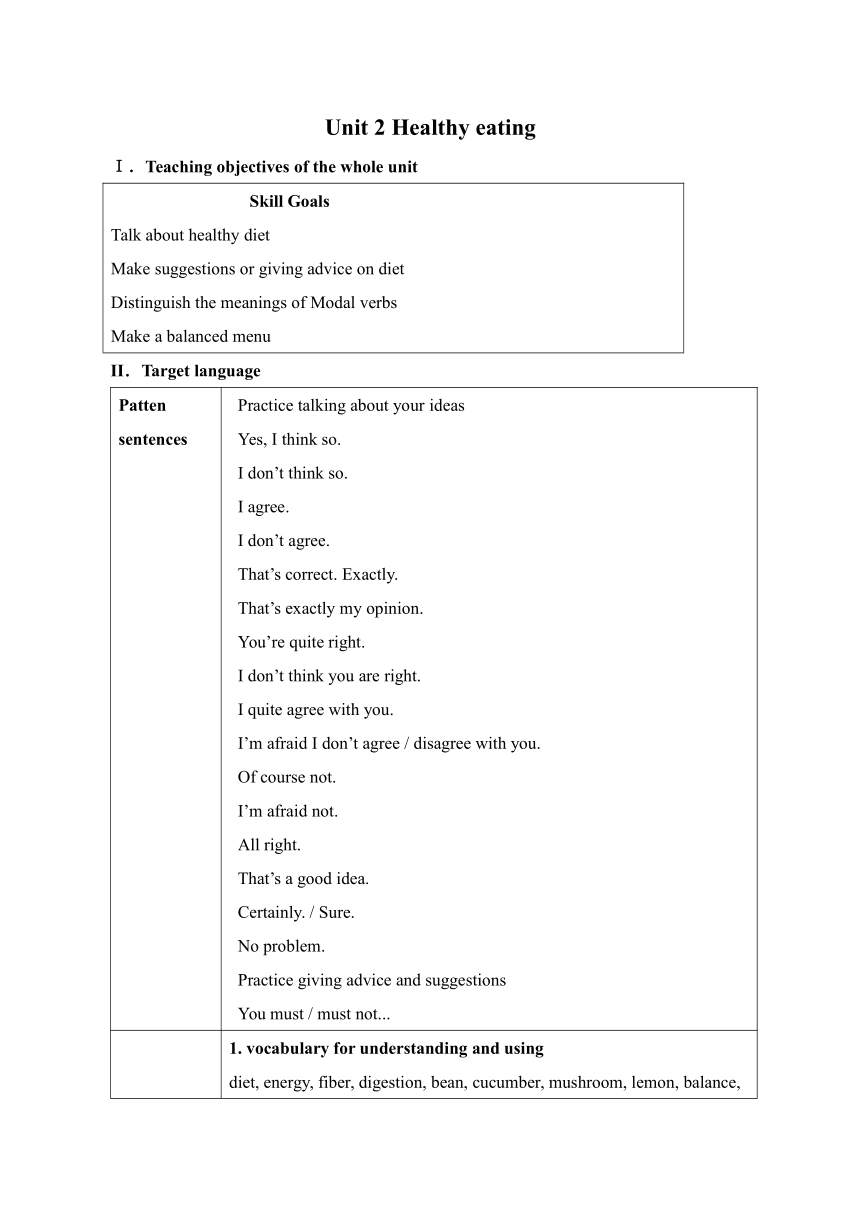 | |
| 格式 | rar | ||
| 文件大小 | 22.0KB | ||
| 资源类型 | 教案 | ||
| 版本资源 | 人教版(新课程标准) | ||
| 科目 | 英语 | ||
| 更新时间 | 2009-03-16 18:33:00 | ||
图片预览

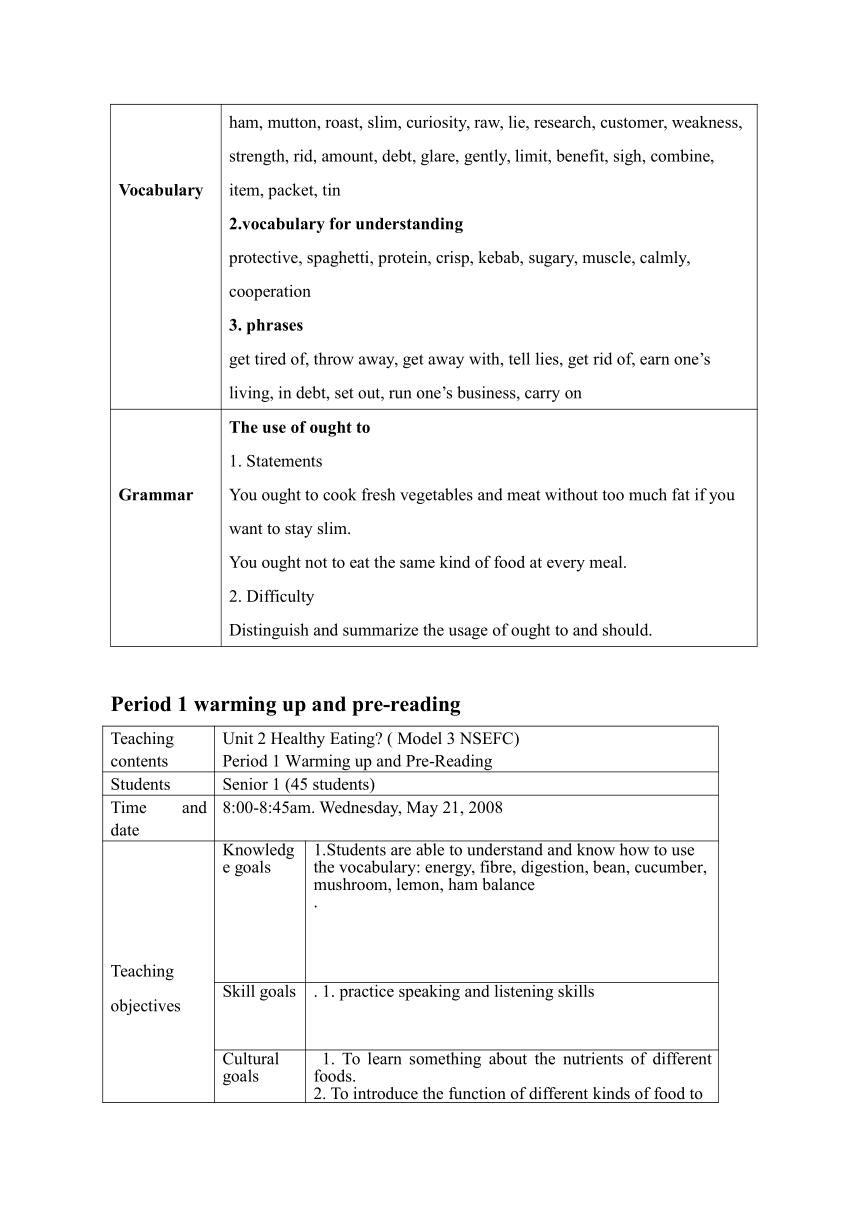
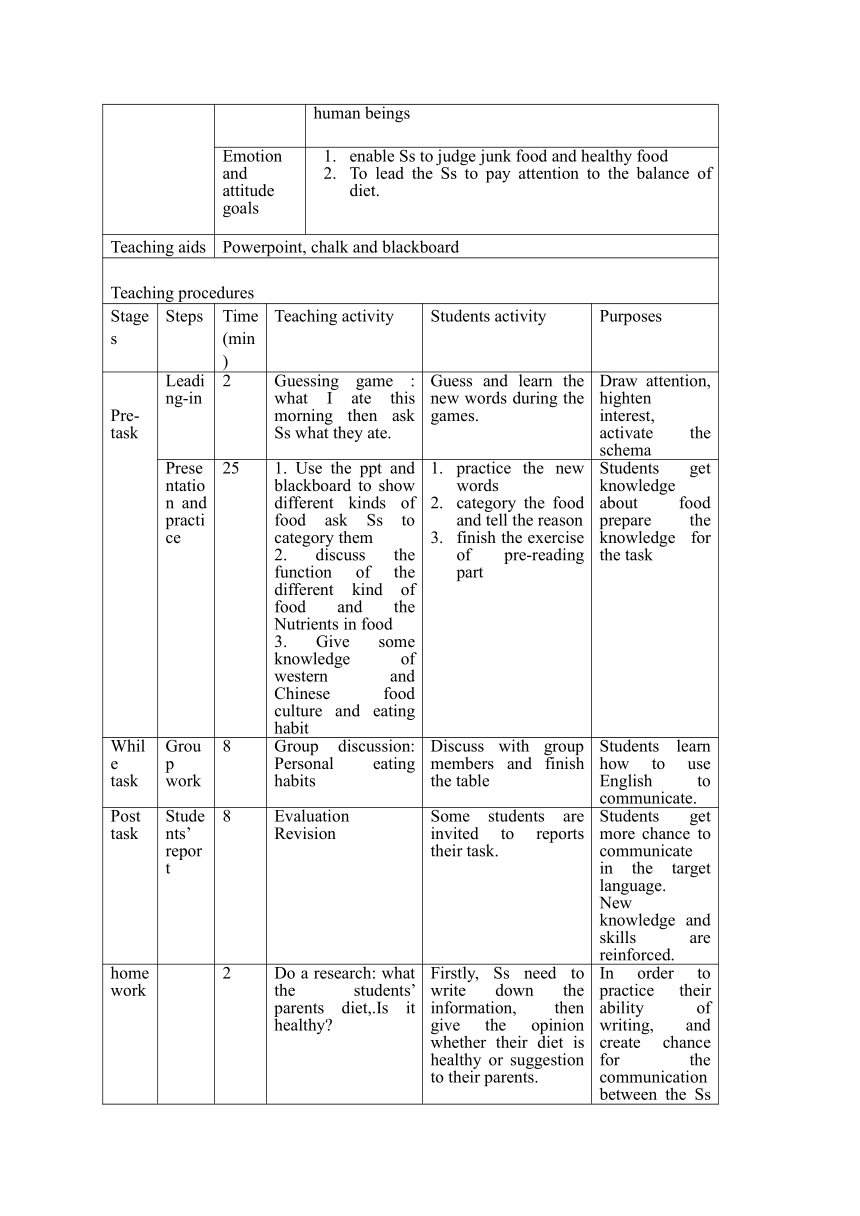
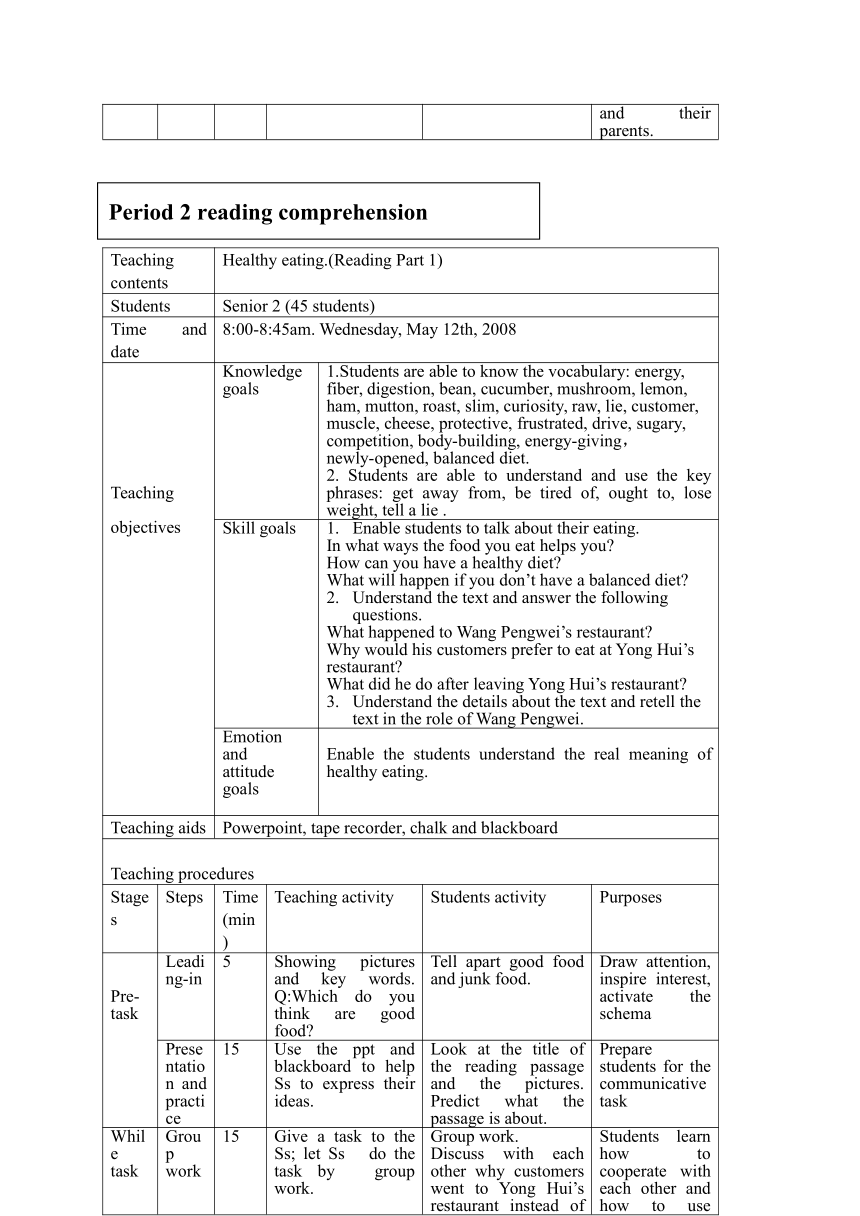
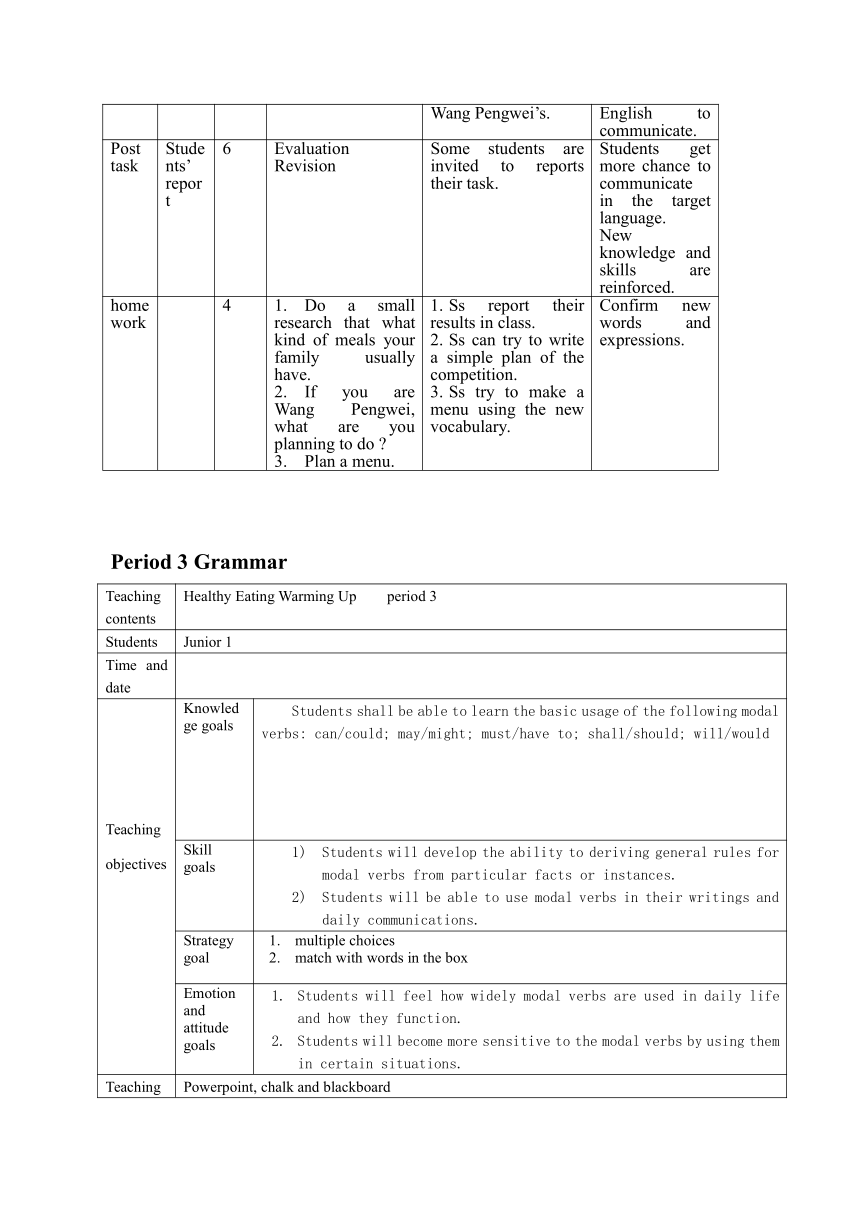
文档简介
Unit 2 Healthy eating
I.Teaching objectives of the whole unit
Skill GoalsTalk about healthy dietMake suggestions or giving advice on dietDistinguish the meanings of Modal verbsMake a balanced menu
II.Target language
Patten sentences Practice talking about your ideasYes, I think so. I don’t think so.I agree. I don’t agree.That’s correct. Exactly. That’s exactly my opinion.You’re quite right.I don’t think you are right.I quite agree with you.I’m afraid I don’t agree / disagree with you. Of course not. I’m afraid not. All right.That’s a good idea.Certainly. / Sure.No problem.Practice giving advice and suggestionsYou must / must not...
Vocabulary 1. vocabulary for understanding and usingdiet, energy, fiber, digestion, bean, cucumber, mushroom, lemon, balance, ham, mutton, roast, slim, curiosity, raw, lie, research, customer, weakness, strength, rid, amount, debt, glare, gently, limit, benefit, sigh, combine, item, packet, tin2.vocabulary for understandingprotective, spaghetti, protein, crisp, kebab, sugary, muscle, calmly, cooperation3. phrasesget tired of, throw away, get away with, tell lies, get rid of, earn one’s living, in debt, set out, run one’s business, carry on
Grammar The use of ought to1. Statements You ought to cook fresh vegetables and meat without too much fat if you want to stay slim.You ought not to eat the same kind of food at every meal.2. DifficultyDistinguish and summarize the usage of ought to and should.
Period 1 warming up and pre-reading
Teaching contents Unit 2 Healthy Eating ( Model 3 NSEFC)Period 1 Warming up and Pre-Reading
Students Senior 1 (45 students)
Time and date 8:00-8:45am. Wednesday, May 21, 2008
Teachingobjectives Knowledge goals 1.Students are able to understand and know how to use the vocabulary: energy, fibre, digestion, bean, cucumber, mushroom, lemon, ham balance.
Skill goals . 1. practice speaking and listening skills
Culturalgoals 1. To learn something about the nutrients of different foods. 2. To introduce the function of different kinds of food to human beings
Emotion and attitude goals enable Ss to judge junk food and healthy foodTo lead the Ss to pay attention to the balance of diet.
Teaching aids Powerpoint, chalk and blackboard
Teaching procedures
Stages Steps Time(min) Teaching activity Students activity Purposes
Pre-task Leading-in 2 Guessing game : what I ate this morning then ask Ss what they ate. Guess and learn the new words during the games. Draw attention, highten interest, activate the schema
Presentation and practice 25 1. Use the ppt and blackboard to show different kinds of food ask Ss to category them2. discuss the function of the different kind of food and the Nutrients in food3. Give some knowledge of western and Chinese food culture and eating habit practice the new words category the food and tell the reasonfinish the exercise of pre-reading part Students get knowledge about food prepare the knowledge for the task
While task Group work 8 Group discussion: Personal eating habits Discuss with group members and finish the table Students learn how to use English to communicate.
Post task Students’ report 8 EvaluationRevision Some students are invited to reports their task. Students get more chance to communicate in the target language.New knowledge and skills are reinforced.
homework 2 Do a research: what the students’ parents diet,.Is it healthy Firstly, Ss need to write down the information, then give the opinion whether their diet is healthy or suggestion to their parents. In order to practice their ability of writing, and create chance for the communication between the Ss and their parents.
Teaching contents Healthy eating.(Reading Part 1)
Students Senior 2 (45 students)
Time and date 8:00-8:45am. Wednesday, May 12th, 2008
Teachingobjectives Knowledge goals 1.Students are able to know the vocabulary: energy, fiber, digestion, bean, cucumber, mushroom, lemon, ham, mutton, roast, slim, curiosity, raw, lie, customer, muscle, cheese, protective, frustrated, drive, sugary, competition, body-building, energy-giving, newly-opened, balanced diet.2. Students are able to understand and use the key phrases: get away from, be tired of, ought to, lose weight, tell a lie .
Skill goals Enable students to talk about their eating.In what ways the food you eat helps you How can you have a healthy diet What will happen if you don’t have a balanced diet Understand the text and answer the following questions.What happened to Wang Pengwei’s restaurant Why would his customers prefer to eat at Yong Hui’s restaurant What did he do after leaving Yong Hui’s restaurant Understand the details about the text and retell the text in the role of Wang Pengwei.
Emotion and attitude goals Enable the students understand the real meaning of healthy eating.
Teaching aids Powerpoint, tape recorder, chalk and blackboard
Teaching procedures
Stages Steps Time(min) Teaching activity Students activity Purposes
Pre-task Leading-in 5 Showing pictures and key words. Q:Which do you think are good food Tell apart good food and junk food. Draw attention, inspire interest, activate the schema
Presentation and practice 15 Use the ppt and blackboard to help Ss to express their ideas. Look at the title of the reading passage and the pictures. Predict what the passage is about. Prepare students for the communicative task
While task Group work 15 Give a task to the Ss; let Ss do the task by group work. Group work. Discuss with each other why customers went to Yong Hui’s restaurant instead of Wang Pengwei’s. Students learn how to cooperate with each other and how to use English to communicate.
Post task Students’ report 6 EvaluationRevision Some students are invited to reports their task. Students get more chance to communicate in the target language.New knowledge and skills are reinforced.
homework 4 Do a small research that what kind of meals your family usually have.If you are Wang Pengwei, what are you planning to do Plan a menu. Ss report their results in class.Ss can try to write a simple plan of the competition.Ss try to make a menu using the new vocabulary. Confirm new words and expressions.
Period 3 Grammar
Teaching contents Healthy Eating Warming Up period 3
Students Junior 1
Time and date
Teachingobjectives Knowledge goals Students shall be able to learn the basic usage of the following modal verbs: can/could; may/might; must/have to; shall/should; will/would
Skill goals Students will develop the ability to deriving general rules for modal verbs from particular facts or instances.Students will be able to use modal verbs in their writings and daily communications.
Strategygoal multiple choicesmatch with words in the box
Emotion and attitude goals Students will feel how widely modal verbs are used in daily life and how they function.Students will become more sensitive to the modal verbs by using them in certain situations.
Teaching aids Powerpoint, chalk and blackboard
Teaching procedures
Stages Time(min) Teaching activity Students activity Purposes
1 5 1 Ask students :What have we learned during the last class …we should have a balanced diet Review knowledge they learned in the last class Pave the way for the main content
10 Please pick out all the sentences containing modal verbs from the reading passage and list them. Match the function words in the box with each of the sentences. Then make three new sentences.A. Intention B. Duty C. Promission D. Possibility E. GuessingBy lunchtime they would all be sold. His restaurant ought to be full of people.What could have happened Nothing could have been better Something terrible must have happened.I will take all that fat off you in two weeks. He could not believe his eyes. practice the model words Let students have a little idea of model verbs
3 22 Analyze similarities and differences between pairs of modal verbs1. ought to/should 1)should 和ought to 都为“应该”的意思,可用于各种人称。ought to 的语气稍重一些。 You ought to (should) follow your teacher’s advice.表示主语的义务或责任: You should take care of your sister. 你应当去照顾你妹妹。 或指出—个正确、明智的动作: They shouldn't allow parking here;the street is too narrow. 这儿不该允许停车;马路太窄了。2)should 和ought to 后面跟动词不定式的完成式,其肯定句表示”过去应该做而未做”, 其否定句则表示”过去不该做但做了”。You should/ought to have made the decision a week ago.I shouldn't have made such a foolish mistake. 多数情况下,ought to 可与should互换使用。ought to的反意疑问句用shouldn’t替代。 2. must和have to must的用法 1)表示主观的义务和必要, 主要用于肯定句和疑问句, 意思为 “必须……,得……,要……”;由must 引起的疑问句,肯定回答要用must或have to, 否定回答要用needn’t或don’t have to, 意思是“不必” ; must的否定形式mustn’t表示禁止,意思是“不能,不许”。如: — Must I finish the task right now 我现在必须完成这个工作吗? —Yes, you must. / Yes, you have to. 是的。 (—No, you needn’t. / No, you don’t have to. 不,不必。) You mustn’t come here without permission.未经允许,你不能来这儿。 have to 的用法 1)must表示一种主观的需要,而have to 表示一种客观的需要,意思是“不得不”。 如: I have to attend an important meeting this afternoon. 今天下午我不得不参加一个重要的会议。 Mother is out, so I have to look after the shop. 妈妈不在家,因此我不得不照看商店。 2)have to 的否定形式是don’t have to, 相当于needn’t。如: They don’t have to buy a computer at present. 他们目前没有必要买电脑。 Ask students to finish 10 multiple choices about model verbs Do exercises Let students have a deep understanding of modal verbs and use them
4 6 Evaluation and revision Some students are invited to give their answers New knowledge and skills are reinforced.
5 2 Homework Finish Ex.2-3 on P13 Finish homework In order to practice their knowledge
Unit 2 Healthy Eating Period 4 Extensive Reading
Teaching contents Unit 2 Healthy Eating ( Model 3 NSEFC)Period 4 Extensive Reading
Students Senior 1 (45 students)
Time and date 8:00-8:45am. Wednesday, May 21, 2008
Teachingobjectives Knowledge goals 1.Students are able to understand and know how to use the vocabulary: earn, glare, limited, benefit, sigh, combine; phrases: look forward to, in debt, spy on, serve sb., chat about, cut down, before long, turn into 2. Students are able to understand and use the following functional proverbs : You are what you eat. First wealth is health. An apple a day keeps the doctor away.
Skill goals 1. Students are able to skim the text and find the main idea.2. Students are able to scan the text and get the specific information.3. Students are able to talk about the content of the text.
Strategygoal Grasp the information quickly and correctly by skimming and scanning,
Affect and cultural goals Enable students to known different food and its function.Enable students to choose healthy food and keep a balance diet.
Teaching aids Powerpoint, tape recorder, chalk and blackboard
Teaching procedures
Stages Steps Time(min) Teaching activity Students activity Purposes
Pre-task Leading-in 5 Review Come and Eat Here(1) ;Let students guess what happens then.Give three proverbs about food. Recall the previous passage , guess the next story, and learn the new proverbs. Draw attention, highten interest, go into the text quickly
Reading and comprehension 25 1.Use the ppt and blackboard to help Ss to lean the new words and phrases first.2. skim and give the question “what happens to Wang Pengwei and Yong Hui 3.scan and give five questions about the text.4. explain the important language points.5. do the exercises on the text book 1. learn the new words and phrases. 2. skim and answer the question3. scan and answer the questions4. do exercises Comprehend the content and get the knowledge about food.
While task Topic Discussion 5 Have a discussion : What can we learn from the passage Discuss with each other about the topic and give the opinion Students learn how how to use English to communicate and express.
Reading exercise 9 Do the Reading task of the work book. Do the Reading task of the work book and finish the exercises Students get more chance to communicate in the target language.New knowledge and skills are reinforced.
homewor 1 Give the task:Collecting attitudes from the Internet. Write down the information. In order to practice their ability search and collect information
Period 5 Listening
Teaching contents Healthy eating(listening part)
Students Senior 2 (45 students)
Time and date 8:00-8:45am,May 20, 2008
Teachingobjectives Knowledge goals Students are able to listen and talk about which food is good for their health.which food is red\orange\green food.
Skill goals 1. Students are able to get the main ideas of the conversation.
Strategygoal Listening and exercises.
Emotion and attitude goals Give the students the idea that we must eat a balanced diet.
Teaching aids Powerpoint, tape recorder, and blackboard
Teaching procedures
Stages Steps Time(min) Teaching activity Students activity Purposes
Pre-task Leading-in 5 Show the students some food pictures Draw attention, interest,
Discussion. 5 Ask Ss to discuss why the food has been divided into these three categories Discuss with their partners . Make the students get the knowledge about the food
While task Listening 25 Playing the tape recorder to the students Listening and get the main idea. Practice their listening skill
Post task Discussion 5 Ask students to think about their own diet and to see whether they have the balanced diet Some students are invited to tall about their diet in the class. Students get more chance to practice their oral English .
homework 5 Ask the students to list the every day diet of their family Give the report next day. Think about their diet deeply.
2
Period 2 reading comprehension
I.Teaching objectives of the whole unit
Skill GoalsTalk about healthy dietMake suggestions or giving advice on dietDistinguish the meanings of Modal verbsMake a balanced menu
II.Target language
Patten sentences Practice talking about your ideasYes, I think so. I don’t think so.I agree. I don’t agree.That’s correct. Exactly. That’s exactly my opinion.You’re quite right.I don’t think you are right.I quite agree with you.I’m afraid I don’t agree / disagree with you. Of course not. I’m afraid not. All right.That’s a good idea.Certainly. / Sure.No problem.Practice giving advice and suggestionsYou must / must not...
Vocabulary 1. vocabulary for understanding and usingdiet, energy, fiber, digestion, bean, cucumber, mushroom, lemon, balance, ham, mutton, roast, slim, curiosity, raw, lie, research, customer, weakness, strength, rid, amount, debt, glare, gently, limit, benefit, sigh, combine, item, packet, tin2.vocabulary for understandingprotective, spaghetti, protein, crisp, kebab, sugary, muscle, calmly, cooperation3. phrasesget tired of, throw away, get away with, tell lies, get rid of, earn one’s living, in debt, set out, run one’s business, carry on
Grammar The use of ought to1. Statements You ought to cook fresh vegetables and meat without too much fat if you want to stay slim.You ought not to eat the same kind of food at every meal.2. DifficultyDistinguish and summarize the usage of ought to and should.
Period 1 warming up and pre-reading
Teaching contents Unit 2 Healthy Eating ( Model 3 NSEFC)Period 1 Warming up and Pre-Reading
Students Senior 1 (45 students)
Time and date 8:00-8:45am. Wednesday, May 21, 2008
Teachingobjectives Knowledge goals 1.Students are able to understand and know how to use the vocabulary: energy, fibre, digestion, bean, cucumber, mushroom, lemon, ham balance.
Skill goals . 1. practice speaking and listening skills
Culturalgoals 1. To learn something about the nutrients of different foods. 2. To introduce the function of different kinds of food to human beings
Emotion and attitude goals enable Ss to judge junk food and healthy foodTo lead the Ss to pay attention to the balance of diet.
Teaching aids Powerpoint, chalk and blackboard
Teaching procedures
Stages Steps Time(min) Teaching activity Students activity Purposes
Pre-task Leading-in 2 Guessing game : what I ate this morning then ask Ss what they ate. Guess and learn the new words during the games. Draw attention, highten interest, activate the schema
Presentation and practice 25 1. Use the ppt and blackboard to show different kinds of food ask Ss to category them2. discuss the function of the different kind of food and the Nutrients in food3. Give some knowledge of western and Chinese food culture and eating habit practice the new words category the food and tell the reasonfinish the exercise of pre-reading part Students get knowledge about food prepare the knowledge for the task
While task Group work 8 Group discussion: Personal eating habits Discuss with group members and finish the table Students learn how to use English to communicate.
Post task Students’ report 8 EvaluationRevision Some students are invited to reports their task. Students get more chance to communicate in the target language.New knowledge and skills are reinforced.
homework 2 Do a research: what the students’ parents diet,.Is it healthy Firstly, Ss need to write down the information, then give the opinion whether their diet is healthy or suggestion to their parents. In order to practice their ability of writing, and create chance for the communication between the Ss and their parents.
Teaching contents Healthy eating.(Reading Part 1)
Students Senior 2 (45 students)
Time and date 8:00-8:45am. Wednesday, May 12th, 2008
Teachingobjectives Knowledge goals 1.Students are able to know the vocabulary: energy, fiber, digestion, bean, cucumber, mushroom, lemon, ham, mutton, roast, slim, curiosity, raw, lie, customer, muscle, cheese, protective, frustrated, drive, sugary, competition, body-building, energy-giving, newly-opened, balanced diet.2. Students are able to understand and use the key phrases: get away from, be tired of, ought to, lose weight, tell a lie .
Skill goals Enable students to talk about their eating.In what ways the food you eat helps you How can you have a healthy diet What will happen if you don’t have a balanced diet Understand the text and answer the following questions.What happened to Wang Pengwei’s restaurant Why would his customers prefer to eat at Yong Hui’s restaurant What did he do after leaving Yong Hui’s restaurant Understand the details about the text and retell the text in the role of Wang Pengwei.
Emotion and attitude goals Enable the students understand the real meaning of healthy eating.
Teaching aids Powerpoint, tape recorder, chalk and blackboard
Teaching procedures
Stages Steps Time(min) Teaching activity Students activity Purposes
Pre-task Leading-in 5 Showing pictures and key words. Q:Which do you think are good food Tell apart good food and junk food. Draw attention, inspire interest, activate the schema
Presentation and practice 15 Use the ppt and blackboard to help Ss to express their ideas. Look at the title of the reading passage and the pictures. Predict what the passage is about. Prepare students for the communicative task
While task Group work 15 Give a task to the Ss; let Ss do the task by group work. Group work. Discuss with each other why customers went to Yong Hui’s restaurant instead of Wang Pengwei’s. Students learn how to cooperate with each other and how to use English to communicate.
Post task Students’ report 6 EvaluationRevision Some students are invited to reports their task. Students get more chance to communicate in the target language.New knowledge and skills are reinforced.
homework 4 Do a small research that what kind of meals your family usually have.If you are Wang Pengwei, what are you planning to do Plan a menu. Ss report their results in class.Ss can try to write a simple plan of the competition.Ss try to make a menu using the new vocabulary. Confirm new words and expressions.
Period 3 Grammar
Teaching contents Healthy Eating Warming Up period 3
Students Junior 1
Time and date
Teachingobjectives Knowledge goals Students shall be able to learn the basic usage of the following modal verbs: can/could; may/might; must/have to; shall/should; will/would
Skill goals Students will develop the ability to deriving general rules for modal verbs from particular facts or instances.Students will be able to use modal verbs in their writings and daily communications.
Strategygoal multiple choicesmatch with words in the box
Emotion and attitude goals Students will feel how widely modal verbs are used in daily life and how they function.Students will become more sensitive to the modal verbs by using them in certain situations.
Teaching aids Powerpoint, chalk and blackboard
Teaching procedures
Stages Time(min) Teaching activity Students activity Purposes
1 5 1 Ask students :What have we learned during the last class …we should have a balanced diet Review knowledge they learned in the last class Pave the way for the main content
10 Please pick out all the sentences containing modal verbs from the reading passage and list them. Match the function words in the box with each of the sentences. Then make three new sentences.A. Intention B. Duty C. Promission D. Possibility E. GuessingBy lunchtime they would all be sold. His restaurant ought to be full of people.What could have happened Nothing could have been better Something terrible must have happened.I will take all that fat off you in two weeks. He could not believe his eyes. practice the model words Let students have a little idea of model verbs
3 22 Analyze similarities and differences between pairs of modal verbs1. ought to/should 1)should 和ought to 都为“应该”的意思,可用于各种人称。ought to 的语气稍重一些。 You ought to (should) follow your teacher’s advice.表示主语的义务或责任: You should take care of your sister. 你应当去照顾你妹妹。 或指出—个正确、明智的动作: They shouldn't allow parking here;the street is too narrow. 这儿不该允许停车;马路太窄了。2)should 和ought to 后面跟动词不定式的完成式,其肯定句表示”过去应该做而未做”, 其否定句则表示”过去不该做但做了”。You should/ought to have made the decision a week ago.I shouldn't have made such a foolish mistake. 多数情况下,ought to 可与should互换使用。ought to的反意疑问句用shouldn’t替代。 2. must和have to must的用法 1)表示主观的义务和必要, 主要用于肯定句和疑问句, 意思为 “必须……,得……,要……”;由must 引起的疑问句,肯定回答要用must或have to, 否定回答要用needn’t或don’t have to, 意思是“不必” ; must的否定形式mustn’t表示禁止,意思是“不能,不许”。如: — Must I finish the task right now 我现在必须完成这个工作吗? —Yes, you must. / Yes, you have to. 是的。 (—No, you needn’t. / No, you don’t have to. 不,不必。) You mustn’t come here without permission.未经允许,你不能来这儿。 have to 的用法 1)must表示一种主观的需要,而have to 表示一种客观的需要,意思是“不得不”。 如: I have to attend an important meeting this afternoon. 今天下午我不得不参加一个重要的会议。 Mother is out, so I have to look after the shop. 妈妈不在家,因此我不得不照看商店。 2)have to 的否定形式是don’t have to, 相当于needn’t。如: They don’t have to buy a computer at present. 他们目前没有必要买电脑。 Ask students to finish 10 multiple choices about model verbs Do exercises Let students have a deep understanding of modal verbs and use them
4 6 Evaluation and revision Some students are invited to give their answers New knowledge and skills are reinforced.
5 2 Homework Finish Ex.2-3 on P13 Finish homework In order to practice their knowledge
Unit 2 Healthy Eating Period 4 Extensive Reading
Teaching contents Unit 2 Healthy Eating ( Model 3 NSEFC)Period 4 Extensive Reading
Students Senior 1 (45 students)
Time and date 8:00-8:45am. Wednesday, May 21, 2008
Teachingobjectives Knowledge goals 1.Students are able to understand and know how to use the vocabulary: earn, glare, limited, benefit, sigh, combine; phrases: look forward to, in debt, spy on, serve sb., chat about, cut down, before long, turn into 2. Students are able to understand and use the following functional proverbs : You are what you eat. First wealth is health. An apple a day keeps the doctor away.
Skill goals 1. Students are able to skim the text and find the main idea.2. Students are able to scan the text and get the specific information.3. Students are able to talk about the content of the text.
Strategygoal Grasp the information quickly and correctly by skimming and scanning,
Affect and cultural goals Enable students to known different food and its function.Enable students to choose healthy food and keep a balance diet.
Teaching aids Powerpoint, tape recorder, chalk and blackboard
Teaching procedures
Stages Steps Time(min) Teaching activity Students activity Purposes
Pre-task Leading-in 5 Review Come and Eat Here(1) ;Let students guess what happens then.Give three proverbs about food. Recall the previous passage , guess the next story, and learn the new proverbs. Draw attention, highten interest, go into the text quickly
Reading and comprehension 25 1.Use the ppt and blackboard to help Ss to lean the new words and phrases first.2. skim and give the question “what happens to Wang Pengwei and Yong Hui 3.scan and give five questions about the text.4. explain the important language points.5. do the exercises on the text book 1. learn the new words and phrases. 2. skim and answer the question3. scan and answer the questions4. do exercises Comprehend the content and get the knowledge about food.
While task Topic Discussion 5 Have a discussion : What can we learn from the passage Discuss with each other about the topic and give the opinion Students learn how how to use English to communicate and express.
Reading exercise 9 Do the Reading task of the work book. Do the Reading task of the work book and finish the exercises Students get more chance to communicate in the target language.New knowledge and skills are reinforced.
homewor 1 Give the task:Collecting attitudes from the Internet. Write down the information. In order to practice their ability search and collect information
Period 5 Listening
Teaching contents Healthy eating(listening part)
Students Senior 2 (45 students)
Time and date 8:00-8:45am,May 20, 2008
Teachingobjectives Knowledge goals Students are able to listen and talk about which food is good for their health.which food is red\orange\green food.
Skill goals 1. Students are able to get the main ideas of the conversation.
Strategygoal Listening and exercises.
Emotion and attitude goals Give the students the idea that we must eat a balanced diet.
Teaching aids Powerpoint, tape recorder, and blackboard
Teaching procedures
Stages Steps Time(min) Teaching activity Students activity Purposes
Pre-task Leading-in 5 Show the students some food pictures Draw attention, interest,
Discussion. 5 Ask Ss to discuss why the food has been divided into these three categories Discuss with their partners . Make the students get the knowledge about the food
While task Listening 25 Playing the tape recorder to the students Listening and get the main idea. Practice their listening skill
Post task Discussion 5 Ask students to think about their own diet and to see whether they have the balanced diet Some students are invited to tall about their diet in the class. Students get more chance to practice their oral English .
homework 5 Ask the students to list the every day diet of their family Give the report next day. Think about their diet deeply.
2
Period 2 reading comprehension
同课章节目录
